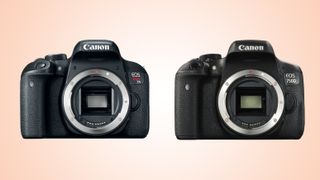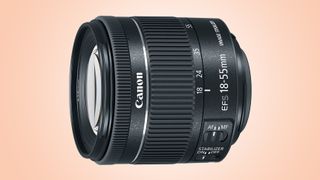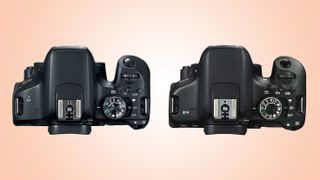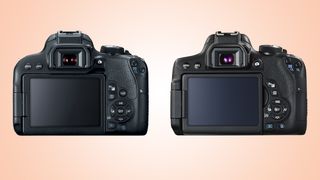Canon EOS Rebel T7i vs T6i: 14 key differences
Canon's entry-level DSLRs compared

Canon’s new EOS Rebel T7i (known as the EOS 800D outside the US) seeks to up the bar for the upper-entry-level DSLR category, and updates the popular EOS Rebel T6i (EOS 750D) that’s just reached its second birthday.
While the EOS Rebel T7i shares much the same intentions as the T6i, and soldiers on with much of the same tech, Canon has made a number of changes across the spec sheet to make it more appealing to the first-time user – some of which were first included inside more premium EOS models.
We've rifled through the spec sheet to find out exactly what Canon has done to separate the new camera from its predecessor. Here’s a rundown of the main changes between the two.
1. Latest DIGIC 7 processor
While the EOS Rebel T6i / EOS 750D employed Canon’s DIGIC 6 processing engine, the latest EOS Rebel T7i / EOS 800D welcomes the newer DIGIC 7 version. This first surfaced inside the PowerShot G7 X Mark II model released last year before being included inside the more recent EOS M5 and PowerShot G9 X II.
Compared with previous engines, this is said to provide superior image processing and faster operation, and it also helps to boost burst speeds (more on this later).
2. Revised sensor

With the same 24.2MP pixel count as the EOS Rebel T6i, the sensor inside the EOS Rebel T7i appears to be unchanged at first glance. The spec sheet, however, reveals it to have a different total pixel count of 25.80MP (vs 24.7MP).
This is the same total pixel count as the sensor inside the EOS 80D, which was newly developed for that model. Canon claims the two share the same technology here, so we should expect to see an improvement over the previous 24.2MP version.
Get daily insight, inspiration and deals in your inbox
Get the hottest deals available in your inbox plus news, reviews, opinion, analysis and more from the TechRadar team.
3. Expanded ISO Range
No doubt a consequence of the revised processor and sensor partnership, the new model features a slightly broader ISO range than before. Where the EOS Rebel T6i could be adjusted over a range of ISO100-12,800 as standard, the new model adds a stop at the latter end to create a native range of ISO 100-25,600.
Similarly, the expanded sensitivity option at the higher end of the scale has now changed from a setting equivalent to ISO25,600 on the EOS Rebel T6i to one equivalent to ISO51,200 on the EOS Rebel T7i.
A more minor change is that, when capturing stills, the entire ISO100-25,600 native range can now be accessed when the camera is set to the Auto ISO setting; previously this was limited to ISO100-6400. When shooting videos, this contracts to an ISO100-12,800 range.
4. New 18-55mm kit lens

Both the EOS Rebel T7i / EOS 800D and EOS 77D are released alongside a new EF-S 18-55mm f/4-5.6 IS STM kit lens, which Canon claims is the smallest non-retractable DSLR kit lens of its focal range.
Weighing 215g, the lens incorporates a four-stop Image Stabilizer to help maintain sharpness in images, as well as Canon’s STM technology, which promises discreet performance when capturing movies.
Some may notice, and be concerned by, the maximum aperture at the wide-angle end. Where this is typically f/3.5 on most kit lenses, this has been reduced by two-thirds of a stop, to f/4.
5. Revised AF system with “the world’s fastest live view autofocus”
The EOS Rebel T6i and its EOS Rebel T6s / EOS 760D sibling shared a 19-point, all-cross-type AF system that featured a single f/2.8-sensitive point in its centre. This was a perfectly sound performer, although the EOS Rebel T6i / EOS 800D packs something much more advanced.
First, the array has been expanded to offer the same 45-point coverage as the EOS 80D, with all of these capable of cross-type performance. 27 points remain operational when using a lens with a maximum aperture of f/8, with nine of these staying cross-type.
Canon has also made a significant improvement to the camera’s sensitivity. Where the working range of the T6i’s system went as low as -0.5EV, this has dropped to -3EV on the T7i. In practice this should make the camera much more sensitive to details in low light, closer to the performance of more advanced models.
Canon also claims the camera offers the world’s fastest live-view autofocus system, with a speeds of just 0.03 sec. As is always the case with these claims, this relates to specific conditions and equipment: here, it relates to APS-C-equipped cameras that have phase-detect pixels on their sensors, and was determined when using the new EF-S 18-55mm f/4-5.6 IS STM at its 55mm setting.
6. More white balance options
You can now opt to shoot with the Auto White Balance set to other Ambience Priority or White Priority, depending on how much of the warmth in the scene you want to retain. Canon has already incorporated this feature inside other recent models, so its inclusion here is somewhat expected.
It’s also now possible to set the colour temperature across the Kelvin scale, something that T6i didn't offer.
7. Faster flash sync speed

Flash sync speed has increased from the EOS Rebel T6i / EOS 750D’s 1/200 sec limit to 1/250 sec on the newer model. Canon has also added a stop to the flash exposure compensation range, taking the previous -/+2EV range up to -/+3EV on the EOS Rebel T7i / EOS 800D.
8. Diffraction correction added to lens corrections
When using lenses whose characteristics were known by the camera, the EOS Rebel T6i allowed for correction of distortion, peripheral illumination and chromatic aberration to be enabled and disabled as required. Now, on the T7i these have been joined by an option that aims to rectify the softening effects of diffraction.
These effects tend to be more prominent when shooting at smaller apertures, so it may interest those intending to use the camera for landscapes and other small-aperture applications. Incidentally, this isn't the first time we’ve seen this feature; it was included in other recent models such as the EOS 5D Mark IV and EOS-1D X Mark II.
9. Raw image processing
The T7i allows for raw images to be processed in camera after capture, something that wasn't possible on the T6i. Controls on offer include adjustment over exposure, white balance and noise reduction.
10. Burst speed boosted
Whereas the Rebel T6i / 750D was capable of firing at approximately 5fps for up to 8 raw frames or 940 JPEGs, the Rebel T7i / 800D can maintain a slightly speedier 6fps burst mode until the card is full (JPEG) or for up to 27 consecutive raw frames. For this to be the case, you need to make sure you’re using a card rated to the UHS-I standard.
11. Dual Pixel CMOS AF system
In place of the Hybrid CMOS AF system of its predecessors, the T7i packs in the same Dual Pixel CMOS AF system seen in the EOS 80D, EOS 5D Mark IV and others. This allows for focus tracking and face detection when using live view and shooting videos.
Furthermore, the fact that the Rebel T7i / 800D retains the T6i’s touchscreen means you can simply tap the screen where you want the camera to focus. This partnership has worked very well on other models, and makes focus-pulling during video recoding easy and professional-looking.
12. Full HD recording now to 60p
While the camera doesn't stretch to offering the same 4K video functionality as some of its more advanced siblings, it does up the maximum frame rate in Full HD recording from the T6i’s 30fps to 60fps (59.94fps).
13. Increased battery life
One of the less-exciting – but still significant – changes is an increase in battery life on the EOS Rebel T7i / EOS 800D. Although the new model uses the same LP-E17 battery as the EOS Rebel T6i / EOS 750D, it promises around 600 frames per charge, compared with the 440 frames managed by the T6i.
Both of these figures are quoted for viewfinder use in typical conditions, and are reduced when using Live View, or when working in colder environments.
Canon has also revised the way in which battery life is presented; there are now six levels on display to help you get a better idea of how much juice you’ve got left, and, if that’s not precise enough, you can also have this displayed as a percentage.
14. New connectivity button

The back plate of the EOS Rebel T7i / EOS 800D appears strikingly similar to that of the EOS Rebel T6i / EOS 750D, although one noticeable difference on the new model is the addition of a new connectivity button.
This works with the camera’s built-in Wi-Fi and NFC options, which also featured on the T6i. The EOS Rebel T7i also features Bluetooth like the more senior EOS 77D.
As on the T6i, a small light on one side of the top plate shows connectivity status, although Canon has chosen to restyle and reposition it slightly for the EOS Rebel T7i / EOS 800D.
Most Popular

